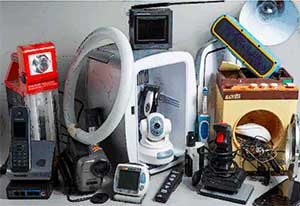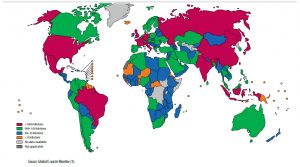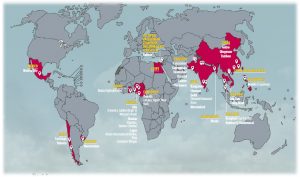Boom. We (tech users on planet Earth) just dumped a record 53.6 million metric tonnes of e-waste. Boom. Our annual total is up 21 per cent in five years. And global e-waste is expected to reach 75 metric tonnes in the next eight years. Boom.

E-waste quantities are rising faster than the world’s population and GDP according to a World Health Organization report. WHO Global E-waste Report.
These stats, compiled in the UN Global E-waste Monitor 2020 report, reveal the dark side of the booming global consumer electronics industry: e-waste is the world’s fastest-growing domestic waste stream.
“E-waste quantities are rising three times faster than the world’s population and 13 per cent faster than the world’s GDP during the last five years,” itemized Antonis Mavropoulos, President, International Solid Waste Association (ISWA), noting the environmental, health and economic pressures such an imbalance creates.
And while Canadians can take some comfort in the web of national laws and provincial regs put in place to help deal with the e-waste explosion, Canada is still one of the world’s worst waste producers overall, and it generated some 750 kilotons of e-waste in 2019.
We do have legislation in place that makes it illegal in to export e-waste from Canada to developing nations – and that’s a good thing.
But not even 18 per cent of the 53.6 million tonnes of e-waste produced globally in 2019 reached recognized waste management or recycling systems. The remainder was either disposed of in illegal landfills or recycled by informal workers, often women and children.
E-waste is not just a nuisance; it can be a killer.

Millions of women, children and adolescents risk adverse health outcomes from what are called informal e-waste recycling activities. WHO Global E-waste Report.
Global e-waste experts, working with both the United Nations and the World Health Organization, have identified links between e-waste recycling and severe health outcomes in children.
As many as 18 million children and adolescents and more than 12 million women, including an unknown number of women of childbearing age, may be at risk from adverse health outcomes linked to what are called informal e-waste recycling activities.
Dumping. Burning and leaching. Cooking. Shredding and dismantling. All are among the informal e-waste recycling methods used.
“Informal and improper e-waste recycling is a major emerging hazard silently affecting our health and that of future generations,” said Maria Neira, Director, Environment, Climate Change and Health Department, World Health Organization (WHO). “One in four children are dying from avoidable environmental exposures. One in four children could be saved, if we take action to protect their health and ensure a safe environment.”

International researchers, scientists, healthcare practitioners and technologists contributed to a WHO report called Children and digital dumpsites. WHO Global E-waste Report.
Inventive and effective (and profitable) in some ways, the informal processing of e-waste is achieved through a combination of physical labour, combustion and chemistry. Through open burning, heating and acid leaching (the use of cyanide salt, nitric acid or mercury) to extract precious metals from tossed or recycled electronics, children and other informal workers can be exposed to a range of hazardous compounds, including heavy metals such as mercury, lead and cadmium, as well as other toxic by-products of plastic and metal processing.
Among the international researchers, scientists, healthcare practitioners and technologists who contributed to a WHO report called Children and digital dumpsites were Canadians Irena Buka, from WHO Collaborating Centre at the University of Alberta, and Jutta Gutberlet, University of Victoria Chemical Safety and Health Unit.
The report noted how dangerous mixtures of e-waste toxicants and hazardous airborne particles get released into the environment by dismantling activities, particularly heating and open burning, as well as the leaching of by-products into water sources. A chemical soup of heavy metals, dioxins, flame retardants, polychlorinated biphenyls (PCBs) and polycyclic aromatic hydrocarbons (PAHs) can be released in the e-waste recycling process – all ingredients listed are harmful to humans.
Seeking to reduce and eliminate such hazardous activities, national and international agencies are coming together to standardize appropriate e-waste management practices through agreements such as the Basel Convention and the Stockholm Convention on Persistent Organic Pollutants. Recently, the WHO joined the international E-waste Coalition as part of efforts to manage and reduce e-waste volume, preventing illegal e-waste trafficking, and support development of what’s called “a circular economy”, one in which resources are recycled and reused in the manufacturing supply chain.

A map showing the source countries of the world’s electronic waste. Magenta/red, followed by green, indicate the top e-waste producing countries. WHO Global E-waste Report.
In fact, some jurisdictions here in Canada are already working towards a circular economy. In Ontario, for example, new electronics regulations came into effect as of January 1, 2021 part of the Resource Recovery and Circular Economy Act.
As mentioned, e-waste recycling programs are running in nine provinces across Canada, operated by the Electronic Products Recycling Association (EPRA).
EPRA’s electronics recycling programs work only with recyclers that have been verified under the national Electronics Recycling Standard so that they maintain appropriate environmental, health and safety controls and are properly handling all materials, ensuring resources are recycled and reused in the manufacturing supply chain.

A map showing the country locations of digital dumpsites around the world. WHO Global E-waste Report.
With the new regulation, Ontario joins those jurisdictions that have moved to an Individual Producer Responsibility model. The Act makes producers environmentally accountable and financially responsible for recovering resources and reducing waste associated with their products and packaging.
Producers can choose to cover the cost of the program by building the cost into their product price or by covering the cost through a recycling fee/environmental handling fee per unit sold.
So, of course, the consumer pays. But better an added fee for our gadgets than a damaged environment or a sick child.
# # #
A PARTIAL LIST OF E-WASTE COMPONENTS
• computers, monitors and motherboards, chips
• wireless devices and other peripheral items
• printers, copiers and fax machines
• telephones, mobile phones and tablets
• video cameras
• televisions
• stereo equipment
• cathode ray tubes
• transformers
• cables and batteries
• lamps and light bulbs (including mercury-containing CFL and
fluorescent bulbs)
• large household appliances (refrigerators, washers, dryers,
microwaves)
• toys and sports equipment
• tools
• e-cigarettes, vapourizers (li-ion batteries)
• medical devices (some microscopes, electronic blood
pressure monitoring devices, electrocardiogram machines,
spectrophotometers, etc.)
Close-up on pile of mixed electronic waste, old broken computer parts and cell phones. WHO Global E-waste Report.
-30-




